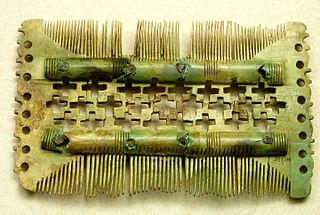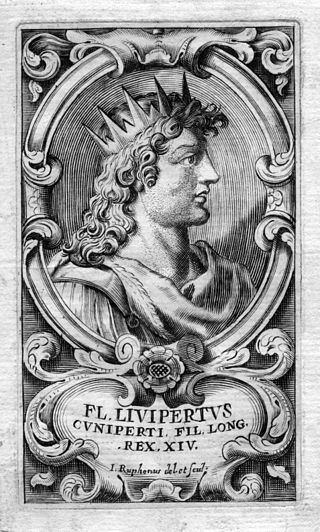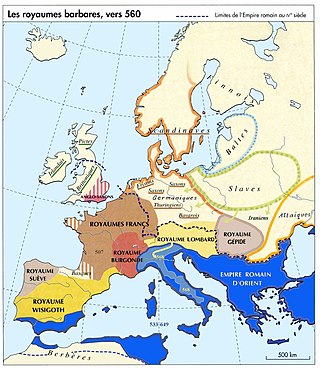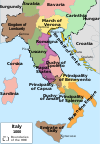
The Lombards or Longobards were a Germanic people who conquered most of the Italian Peninsula between 568 and 774.

The Thuringii, Toringi or Teuriochaimai were an early Germanic people that appeared during the late Migration Period in the Harz Mountains of central Germania, a region still known today as Thuringia. It became a kingdom, which came into conflict with the Merovingian Franks, and it later came under their influence and Frankish control. The name is still used for one of modern Germany's federal states (Bundesländer).

The Duchy of Spoleto was a Lombard territory founded about 570 in central Italy by the Lombard dux Faroald. Its capital was the city of Spoleto.

The Duchy of Bavaria was a frontier region in the southeastern part of the Merovingian kingdom from the sixth through the eighth century. It was settled by Bavarian tribes and ruled by dukes (duces) under Frankish overlordship. A new duchy was created from this area during the decline of the Carolingian Empire in the late ninth century. It became one of the stem duchies of the East Frankish realm which evolved as the Kingdom of Germany and the Holy Roman Empire.

Rothari, of the house of Arodus, was king of the Lombards from 636 to 652; previously he had been duke of Brescia. He succeeded Arioald, who was an Arian like himself, and was one of the most energetic of Lombard kings. Fredegar relates that at the beginning of his reign he put to death many insubordinate nobles, and that in his efforts for peace he maintained very strict discipline.

Agilulf, called the Thuringian and nicknamed Ago, was a duke of Turin and king of the Lombards from 591 until his death.
Arioald was the Lombard king of Italy from 626 to 636. Duke of Turin, he married the princess Gundeberga, daughter of King Agilulf and his queen Theodelinda. He was, unlike his father-in-law, an Arian who did not accept Catholicism.
Rodoald, was a Lombard king of Italy, who succeeded his father Rothari on the throne in 652. He was said to be lecherous and he was assassinated after a reign of just six months in 653 by the husband of one of his lovers. Paul the Deacon writes that Rodoald "had reigned five years and seven days, ", although historians note that this length of reign is suspect. Aripert, a rival claimant, was elected with the support of the Catholic Church, which opposed the Arian monarchy.

Liutpert was the Lombard king of Italy between 700 and 702, with interruption. Upon succeeding his father, King Cunincpert, at a young age, he ruled together with his tutor, Ansprand, the duke of Asti. After eight months, he was deposed by Raginpert, the duke of Turin and son of Godepert, Liutpert's great-uncle, but succeeded in returning to the throne several months later upon Raginpert's death, only to be deposed again, taken captive from Pavia, and drowned by Aripert II, Raginpert's son. He was buried in the Basilica of Santissimo Salvatore in Pavia.

Aripert I was king of the Lombards (653–661) in Italy. He was the son of Gundoald, Duke of Asti, who had crossed the Alps from Bavaria with his sister Theodelinda. As a relative of the Bavarian ducal house, his was called the Bavarian Dynasty.

Ansprand was king of the Lombards briefly in 712. Before that, he was the duke of Asti and regent during the minority of Liutpert (700–701). He was defeated at Novara by Raginpert and exiled during the subsequent war over the succession, fleeing to the court of Theudebert, duke of Bavaria, in 702.

Aripert II was the king of the Lombards from 701 to 712. Duke of Turin and son of King Raginpert, and thus a scion of the Bavarian Dynasty, he was associated with the throne as early as 700. He was removed by Liutpert, who reigned from 700 to 702, with the exception of the year 701, when Raginpert seized the throne. After his father's death, he tried to take the throne, too. He defeated Liutpert and the regent Ansprand's men at Pavia and captured the king, whom he later had strangled in his bath. He seized the capital and forced Ansprand over the Alps. He was firmly in power by 703.

Alduin was king of the Lombards from 547 to 560.

Perctarit was the first Catholic king of the Lombards who lead a religiously divided kingdom during the 7th Century. He ruled from 661 to 662 the first time and later from 671 to 688. He is significant for making Catholicism the official religion, sparing the life of an invading leader, and building projects around the capital.
Raginpert was the Duke of Turin and then King of the Lombards briefly in 701. He was the son of Godepert and grandson of Aripert I. He usurped the throne in 701 and removed Liutpert, his grandnephew, putting his son Aripert in line for the succession. He and his Neustrians went out to meet the regent, Ansprand, in battle and defeated him at Novara, but died shortly after. His son Aripert did not succeed in taking the throne right away.
Walthari son of Wacho from his third wife Silinga, was a king of the Lombards from 539 to 546. He was an infant king, and rulership of the kingdom was administered by Audoin. Audoin probably killed Waltari before he reached manhood, in order to gain the throne for himself around 546, and led the Lombards into Pannonia. Procopius mentions he died of disease. He was the last of the Lething Dynasty.
Garibald was the young son of Grimoald I of Benevento, king of the Lombards, and Theodota, daughter of Aripert I. After his father's death in 671, he reigned briefly for three months until the numerous adherents of Perctarit, his uncle, who had been exiled by Grimoald nine years earlier, besought their candidate to return and elected him, deposing the young king. He was the last Arian king in Europe.

The Kingdom of Italy, also called Imperial Italy, was one of the constituent kingdoms of the Holy Roman Empire, along with the kingdoms of Germany, Bohemia, and Burgundy. It originally comprised large parts of northern and central Italy. Its original capital was Pavia until the 11th century.
Duke of Turin was the title of a line of dukes among the Lombards when they ruled Italy in the Early Middle Ages.













